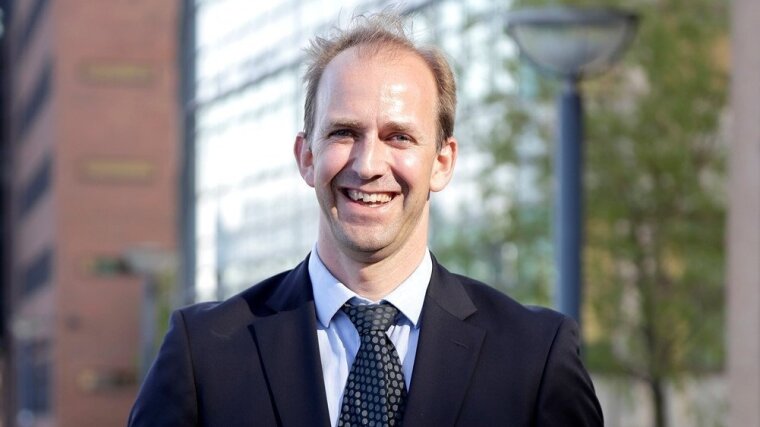
N. Asger Mortensen, Professor at the Department of Photonics Engineering, Technical University of Denmark, is visiting the Abbe Center of Photonics as ASP Visiting Professor in March/April 2015. During his stay he will give a number of lectures.
Prof. N. Asger Mortensen was a full professor at the Technical University of DenmarkExternal link (DTU), where he has been a faculty since 2004. He was affiliated with the Department of Photonics EngineeringExternal link (DTU Fotonik) and he is a key-investigator and co-applicant on two Centers of Excellence: the Villum Foundation CoE for Nanophotonics for Terabit CommunicationsExternal link (NATEC) and the DNRF CoE for Nanostructured GrapheneExternal link (CNG).
Together with his research group and collaborators, Prof. Mortensen has over the years made pioneering contributions in condensed-matter physics, optics, and nanotechnology, including areas such as quantum-electron transport (Coulomb drag relevant to gate-limited mobility in the smallest transistors), fiber optics (including foundational theory of microstructured fibers and photonic-bandgap fibers), nanofluidics (with pioneering eigenfunction approach to mass/charge transport equations), optofluidics in lab-on-a-chip systems (including the proposal of slow-light enhanced sensors), band-structure engineering of low-dimensional electron systems (co-inventing the graphene anti-dot lattices), nanophotonics (pointing out fundamental limitations to slow-light enhanced light-matter interaction), metamaterials (including demonstrations of carpet invisibility cloaks), and more recently nanoplasmonics (including pioneering developments of semiclassical nonlocal theory and experimental explorations of possible quantum plasmonics in metallic nanostructures).
His research group presently focuses on novel wave phenomena in plasmonic nanostructures (ranging from noble metals to graphene nanostructures), using both theory developments (bridging classical electrodynamics and quantum DFT descriptions) and various experimental approaches (including near/far-field spectroscopy, FTIR spectroscopy, and electron-energy loss spectroscopy). Stimulated by the fundamental discoveries, plasmonics for large-scale structured colors in consumer products are being explored in both national and European collaborations.
After his PhD work in mesoscopic physics at DTU (including visiting positions at the Niels Bohr Institute at University of Copenhagen and the Instituut-Lorentz at Universiteit Leiden), N. Asger Mortensen joined the world-leading developer and provider of photonic crystal fibers, the Danish-based Crystal Fibre A/SExternal link, as research scientist (2001-2004). N. Asger Mortensen was in 2006 awarded the Doctor Technices degree (the highest Danish academic degree somewhat equivalent to a German habilitation) from DTU for his internationally leading research work on photonic crystal fibers that he conducted during his affiliation with industry. He returned to academia to become an associate professor at DTU in 2004 (tenured in 2005 and full professor since 2011).
N. Asger Mortensen has co-authored 170+ publications published in recognized international peer-review journals (h=34) and he is the co-inventor of several inventions, including 2 US patents being commercially explored by Crystal Fibre A/S. He is routinely invited to talk about his research in the most prestigious conferences and workshops of Nanophotonics. His expert advice is frequently requested by leading international funding agencies and he is serving as an OSA associate editor for Optics Express (since 2010). His contributions have been recognized by numerous national and international honors, including European Optical Prizes from EOS, and he is a fellow of the SPIE.
website of the Mortensen group (personal)External link
Lecture 1: Nanoplasmonics: From Classical Electrodynamics to Possible Quantum Mechanical Phenomena (general talk)
Time: March 5, 2015, 14:00
Place: Fraunhofer Institute IOF, Zeiss room
Lecture 2: Nanophotonic Approaches to Enhanced Light-Matter Interactions: Slow-Light Effects
Time: March 19, 2015, 11:00
Place: Institute of Applied Physics, Seminar room
Lecture 3: Nanophotonic Approaches to Enhanced Light-Matter Interactions: Field-Enhancement Effects
Time: March 25, 2015, 13:30
Place: Institute of Applied Physics, Seminar room
Lecture 4: Nanoplasmonics Probed by Fast Electrons
Time: March 31, 2015, 11:00
Place: Institute of Applied Physics, Seminar room
Lecture 5: Semi-Classical Approach to Nonlocal Plasmonic Response: Hydrodynamics
Time: April 8, 2015, 13:30
Place: Institute of Applied Physics, Seminar room
Lecture 6: Semi-Classical Approach to Nonlocal Plasmonic Response: Extended Approaches
Time: April 14, 2015, 14:30
Place: Institute of Applied Physics, Seminar room
Lecture 7: Graphene Plasmonics (& beyond)
Time: April 21, 2015, 14:30
Place: Institute of Applied Physics, Seminar room
Lecture 8: Quantum Plasmonics in Metallic Nanostructures
Time: April 29, 2015, 15:00/new: April 30, 2015, 13:00
Place: Institute of Applied Physics, Seminar room